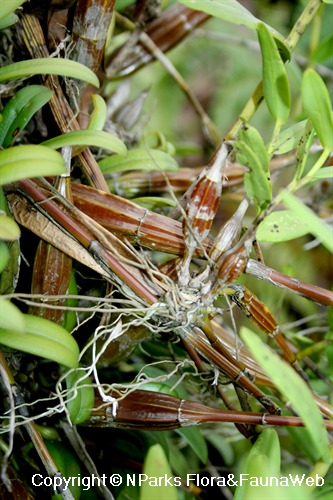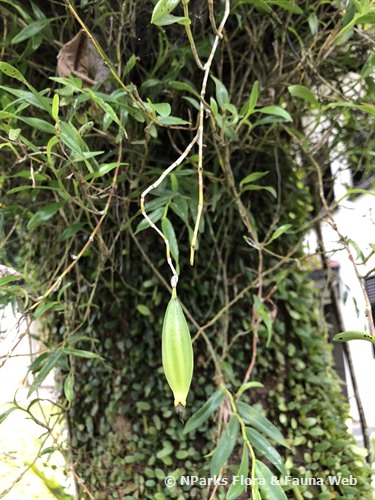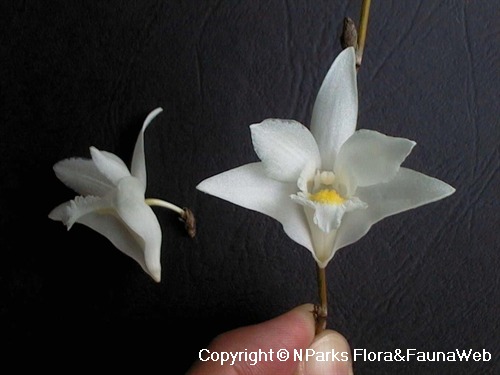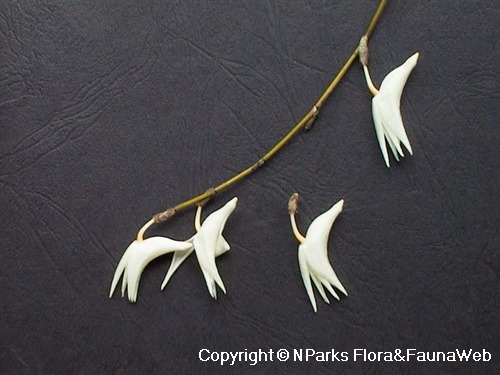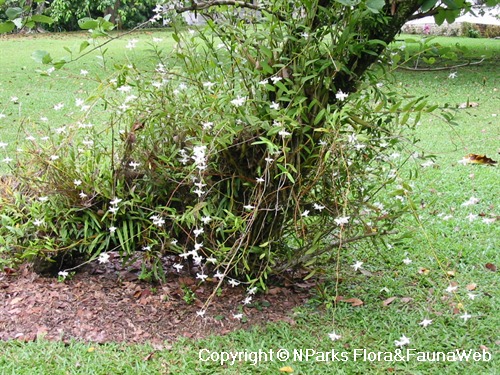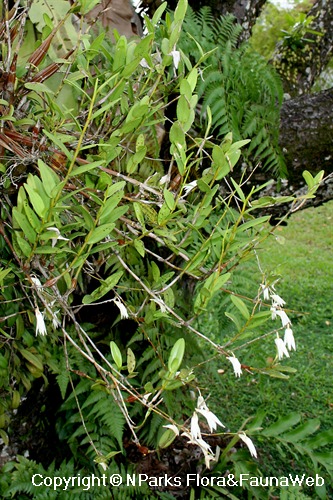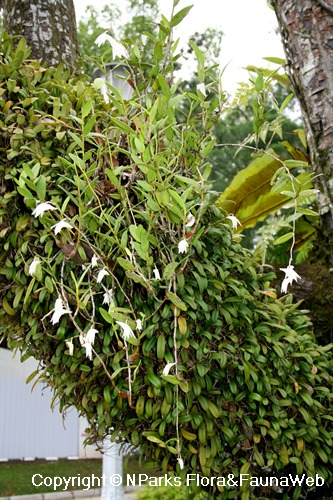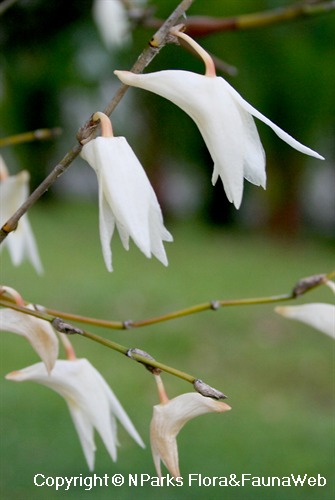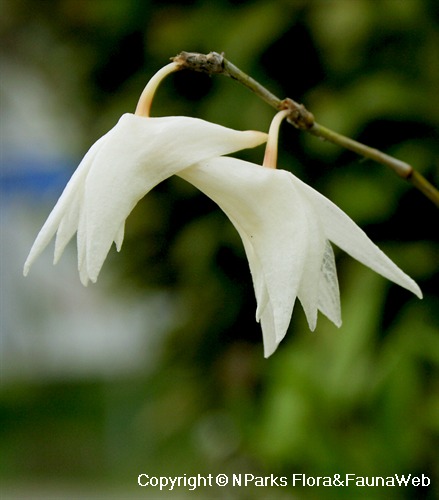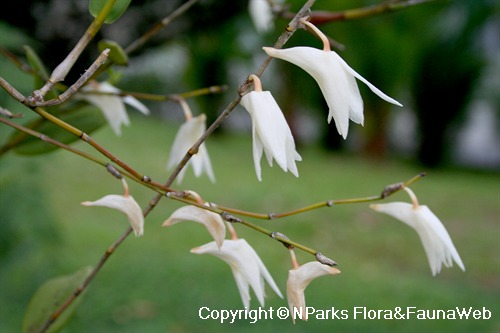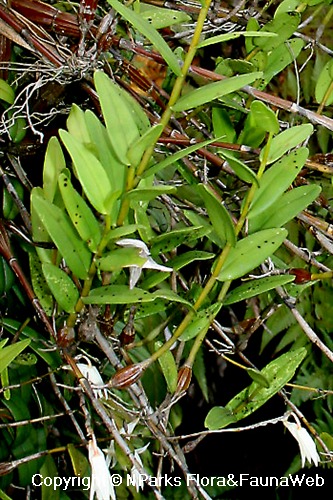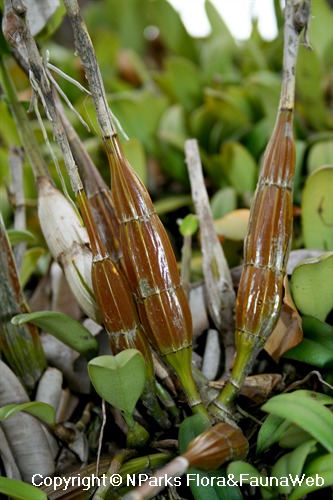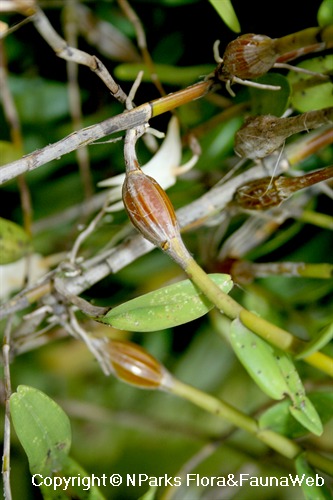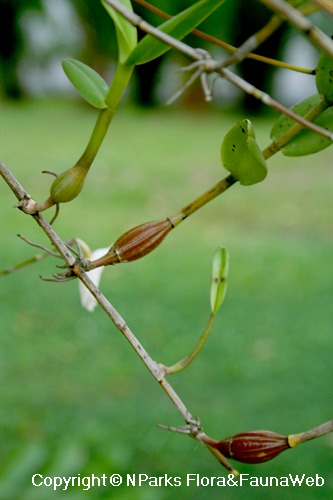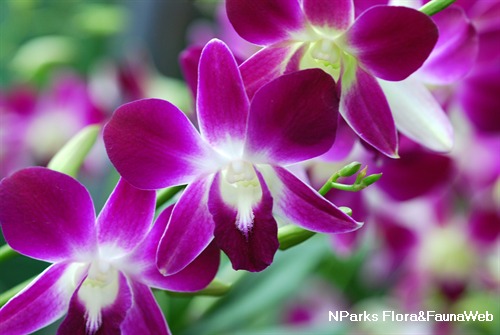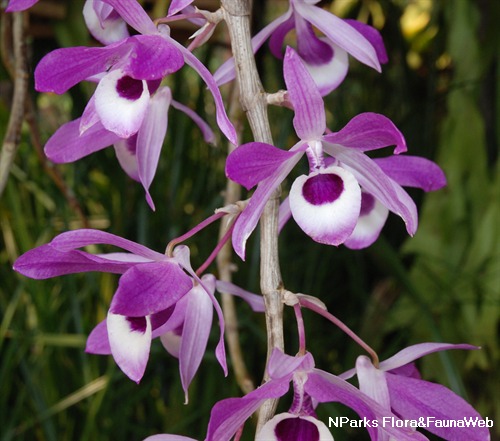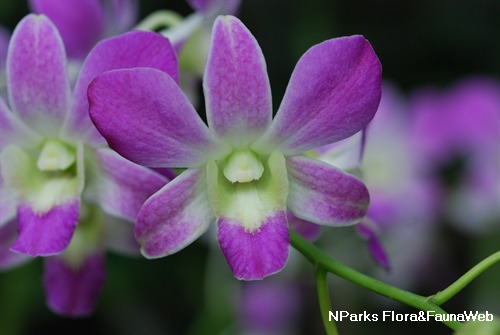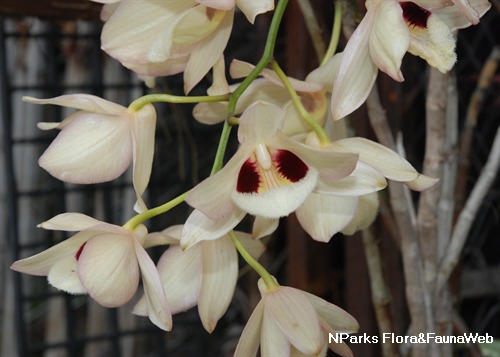.jpg)
Back
Dendrobium crumenatum Sw.
| Family Name: | Orchidaceae |
| Synonyms: | Mokara crumenatum, Epidendrum caninum, Aporum crumenatum, Mokara crumenata, Dendrobium kwashotense |
| Common Name: | Pigeon Orchid, White Dove Orchid, Pigeon Flower, Sparrow Orchid, Bag-shaped Dendrobium, Anggerek Merpati, Daun Sepulih Tulang, 鸽子兰, 木石斛, 鸽子斛 |
Name
Classifications and Characteristics
| Plant Division | Angiosperms (Flowering Seed Plants) (Monocotyledon) |
|---|---|
| Plant Growth Form | Epiphyte |
| Lifespan (in Singapore) | Perennial |
| Mode of Nutrition | Autotrophic |
| Plant Shape | Shrubby |
Biogeography
| Native Distribution | India, Sri Lanka, South China, Taiwan, Myanmar, Cambodia, Laos, Vietnam, Thailand, Peninsular Malaysia, Sumatra, Java, Borneo, Philippines, Lesser Sunda Islands, New Guinea, Australia (Christmas Islands). |
|---|---|
| Native Habitat | Terrestrial (Primary Rainforest) |
| Preferred Climate Zone | Tropical, Sub-Tropical / Monsoonal |
| Local Conservation Status | Native to Singapore (Least Concern (LC)) |
| CITES Protection | True (Appendix II) |
Description and Ethnobotany
| Growth Form | A sympodial, epiphytic, lowland orchid. |
|---|---|
| Foliage | The leaves are coriaceous, deciduous and lanceolate to elliptical in shape while being slightly notched at the leaf apex. |
| Stems | The multiple stems can grow up to 30cm in length which are basally enlarged, end off at slender tips and are covered with scarious sheaths 2 to 3cm long. The stems have a pendulous growth habit. |
| Flowers | The white flowers are fragrant with a yellow tinted throat and have a short lifespan, the flowers last less than a day. |
| Habitat | It is found in semi-deciduous and deciduous dry lowland forests and savannah-like woodlands at an altitude of 500 metres. |
| Etymology | The flower buds look somewhat like little pigeons hence its common name 'Pigeon Orchid'. The species name is derived from the latin word 'crumenatus' meaning 'bag-shaped'. |
| Ethnobotanical Uses | Food (Herb or Spice) Others: Medicinal: Leaf poultice applied to pimples and boils by Malays and Indonesians. Juice from swollen pseudobulbs used as eardrops to treat earache. Common name Daun Sepulih Tulang (Bone Restoring Leaf) suggests use as treatment for bone-related ailments. Products: Stem fibres used to make braiding materials for hats in Philippines. Cultural: Planted near entrance of house in some Malaysian states as a good-luck talisman to ward off evil spirits from entering house. |
Landscaping Features
| Desirable Plant Features | Ornamental Flowers, Fragrant (Flowers) (Day) |
|---|---|
| Landscape Uses | Coastal, Vertical Greenery / Green Wall |
| Thematic Landscaping | Fragrant / Aromatherapy Garden, Naturalistic Garden |
Fauna, Pollination and Dispersal
| Pollination Method(s) | Abiotic (Wind) |
|---|---|
| Seed or Spore Dispersal | Abiotic (Explosive Dehiscence) |
Plant Care and Propagation
| Light Preference | Semi-Shade, Full Sun |
|---|---|
| Water Preference | Little Water |
| Plant Growth Rate | Fast |
| Rootzone Tolerance | Shallow Media, Drought Tolerant |
| Maintenance Requirements | Moderate |
| Propagation Method | Seed, Division, Tissue Culture |
Foliar
| Foliage Retention | Evergreen |
|---|---|
| Mature Foliage Colour(s) | Green |
| Mature Foliage Texture(s) | Smooth, Leathery, Thick |
| Foliar Type | Simple / Unifoliate |
| Foliar Venation | Parallel |
| Foliar Margin | Entire |
Non - Foliar and Storage
| Stem Type & Modification | Acaulescent |
|---|---|
| Root Type | Underground (Fibrous Root), Aboveground (Aerial Root) |
| Specialised Storage Organ(s) | Underground (Rhizome), Aboveground |
Floral (Angiosperm)
| Flower & Plant Sexuality | Unisexual Flowers , Dioecious |
| Flower Colour(s) | White |
|---|
| Flower Symmetry | Bilateral |
| Flowering Opening Time | Daytime |
| Flower Lifespan on Plant | 1 Day |
| Flowering Habit | Polycarpic |
Fruit, Seed and Spore
| Mature Fruit Colour(s) | Black, Brown |
|---|---|
| Fruit Classification | Simple Fruit |
| Fruit Type | Dehiscent Dry Fruit , Capsule |
Image Repository
Others
| Master ID | 629 |
|---|---|
| Species ID | 1924 |
| Flora Disclaimer | The information in this website has been compiled from reliable sources, such as reference works on medicinal plants. It is not a substitute for medical advice or treatment and NParks does not purport to provide any medical advice. Readers should always consult his/her physician before using or consuming a plant for medicinal purposes. |

.jpg)
.jpg)
.jpg)
